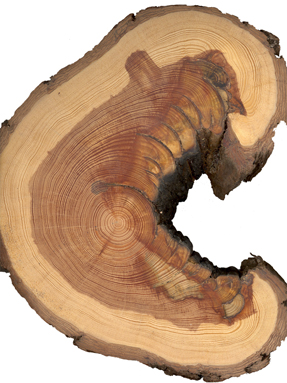This article is part of the Wildland Fire Learning In Depth series. It is designed for students who want to learn more about fire. Find the complete series on the Fire subject site.

Photo courtesy of Henri D. Grissino-Mayer, Department of Geography, The University of Tennessee-Knoxville.
Fire ecology is a branch of ecology that concentrates on the origins of wildland fire and its relationship to the living and nonliving environment. This school of thought recognizes that fire is a natural process operating as a component of an ecosystem.
To understand an ecosystem requires looking beyond the system’s present state. Full understanding includes an investigation of the ecosystem’s origin, possible future stages of the ecosystem, and the cycles through which the ecosystem progresses. Fire, similar to floods, earthquakes, storms, etc., can be viewed as one catalyst promoting changes in an ecosystem.
In the 1930s, researchers in the southern United States challenged the negative accepted wisdom about fire. They argued that fire was essential to animals and the longleaf pine forests of that region. This idea of fire dependence is the first concept of fire ecology. Fire dependence applies to species of plants that rely on the effects of fire to make the environment more hospitable for their regeneration and growth. For example, fire prepares the soil for seeding by making nutrients more available for plant use. As a result, competition from other species that may absorb needed nutrients or shade out necessary sunlight is reduced.
Fire History
The second concept of fire ecology is fire history, which is how often fires occur in a given geographical area. Trees actually record fire history. Each year a tree adds a layer of cells, increasing the width of its trunk. When a fire passes through a forest, trees may be only scorched. A layer of charcoal remains on a living tree and, in time, is enveloped by a layer of new growth. These fire scars provide a record that scientists can use to determine when in history a fire occurred.
Fire Regime
The role fire plays in an ecosystem varies with the characteristics under which the ecosystem evolved. This role is the third concept of fire ecology--fire regime. The interactions of humidity, fuels, and ignition sources will determine the fire regime for a particular land area. A fire regime is a function of the frequency of fire occurrence, the fire intensity, and the amount of fuel consumed. Both frequency and intensity of fire vary and are interdependent. Frequency of fire is largely determined by the ignition source(s) and the duration and character of weather that favors the spread of fire. Intensity of fire is determined by the quantity of fuel available and the fuels' combustion rates. The interaction between frequency and intensity of fires also will be influenced by wind and topography.
Part of a series of articles titled Wildland Fire - Learning In Depth.
Previous: Wildland Fire Engines
Last updated: February 13, 2017
